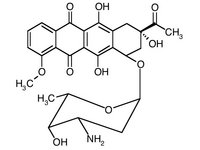A 50-year-old white man presented with a 6-day history of generalized rash, chills, abdominal pain, and mild diarrhea. He also reported a 1- to 2-month history of poor appetite and moderate weight loss. His personal medical history and family history were unremarkable. Physical examination revealed numerous 1- to 10-mm, red-to-violaceous, firm papules and nodules over his entire body (Figure 1) and face. Gingival hypertrophy and hepatosplenomegaly were also noted. His laboratory data were as follows: hemoglobin, 10.3 g/dL (reference range, 13.5-17.0 g/dL); white blood cells, 203 6000/µL (reference range, 45000 -11000/µL); and platelets, 72000/µL (reference range, 1500000 -450000/µL). Blood and urine cultures were negative for bacteria or fungi.
Peripheral blood smears revealed that 67% of the white blood cells were blasts and 25% were promonocytes and atypical monocytes. Bone marrow core biopsy and clot sections showed hypercellular bone marrow with sheets of undifferentiated cells. On bone marrow aspirate smears, 97% of nucleated cells were composed of 2 types of immature cells; the first group was large cells with abundant basophilic cytoplasm, round nuclei, delicate chromatin, and 1 or more prominent nucleoli (monoblasts); the other group had a more irregular and delicately convoluted nuclear configuration (promonocytes). Approximately 80% of the immature cells showed intense nonspecific butyrate esterase activity (Figure 2), whereas only 5% showed naphthol-ASD-chloroacetate esterase positivity. The morphologic and cytochemical findings were compatible with a diagnosis of acute monocytic leukemia (M5b). Flow cytometric analysis of bone marrow aspirate revealed a complex blast cluster with both undifferentiated blast and monoblast-promonocyte clusters. They had a composite antigen profile of CD7^sup +^ (partial dim), CD1b^sup +^, CD13^sup +^, CD14^sup +^ (minority), CD15^sup +^, CD33^sup +^, CD34^sup +^ (minority), CD56^sup +^ (minority dim), CD61^sup -^, CD117^sup +^, CD235a^sup -^, and HLA-DR^sup +^. The monoblast-promonocyte cluster has the most CD11b^sup +^/CD14^sup +^ blasts. These results confirmed our diagnosis.
A skin biopsy specimen (Figure 3) taken from the left medial thigh revealed a Grenz zone and a dense infiltrate of atypical cells throughout the dermis. The cells displayed indented nuclei, hyperchromasia, and brisk mitotic activity, lmmunohistochemical staining for KPl (CD68) was positive. The findings were consistent with cutaneous manifestation of leukemia (leukemia cutis). Cytogenetic analysis of peripheral blood and bone marrow aspirate revealed normal male karyotype 46,XY.
Despite induction of chemotherapy with idarubicin and cytarabine, the patient's condition deteriorated rapidly, with subsequent development of mental status changes, congestive heart failure, respiratory distress, and disseminated intravascular coagulation. He died 10 days after initial presentation.
Cutaneous infiltrates have been described in all forms of acute myeloid leukemia and many forms of myeloproliferative disease. These infiltrates have been divided into specific (leukemia cutis) and nonspecific lesions. Extra-medullary disease is more common in acute monoblastic or monocytic leukemia than in other subtypes of leukemia. Patients with acute monoblastic or monocytic leukemia have the highest incidence of leukemic skin infiltrates, which occur in 10% to 30% of patients.1 Leukemic gingival hyperplasia is the characteristic feature of acute monoblastic or monocytic leukemia, occurring in up to 60% of patients.2 Rarely, cutaneous manifestations may precede hematologic evidence of disease (aleukemia cutis).3 Dissemination to the skin is generally associated with a poor prognosis.3
References
1. Buechner SA, Su WPD. Leukemia tutis. In: Arndt KA, Robinson IK, Leboit PE, et al, eds. Cutaneous Medicine and Surgery. Philadelphia, Pa: WB Saunders; 1996:1670-1673.
2. Dreizen S, McCredie KB, Keating MJ, et al. Malignant gingival and skin "infiltrates" in adult leukemia. Oral Surg Oral Med Oral Pathol. 1983;55:572.
3. Reinhardt D, Pekrun A, Lakomek M, Zimmerman M, Ritter J, Creutzig U. Primary myelosarcomas are associated with a high rate of relapse: report on 34 children from the acute myeloid leukemia-Berlin-Frankfurt-Munster studies. Br J Haematol. 2000:110:863-866.
LeiLei Chen, MD, PhD; Tanya Reddick Rodgers, MD; Marsha L. Chaffins, MD; Koichi Maeda, MD
Accepted for publication September 9, 2004.
From the Departments of Pathology (Drs Chen and Maeda) and Dermatology (Drs Rodgers and Chaffins), Henry Ford Hospital, Detroit, Mich.
Presented in part at the 41 st Annual Meeting of the American Society of Dermatopathology, Boston, Mass, October 2004.
The authors have no relevant financial interest in the products or companies described in this article.
Reprints: Koichi Maeda, MD, Department of Pathology K-6, Henry Ford Hospital, 2799 W Grand Blvd, Detroit, Ml 48202 (e-mail: KMAEDA1@hfhs.org).
Copyright College of American Pathologists Mar 2005
Provided by ProQuest Information and Learning Company. All rights Reserved



